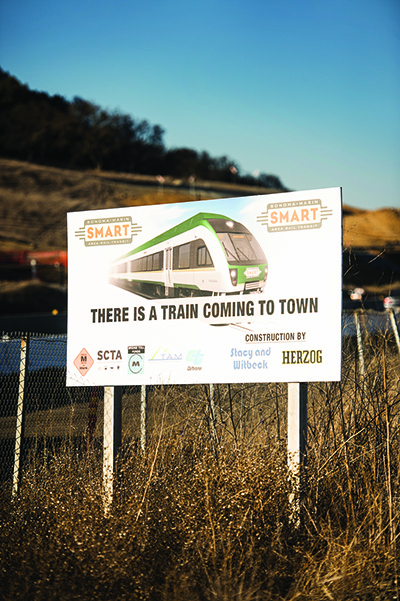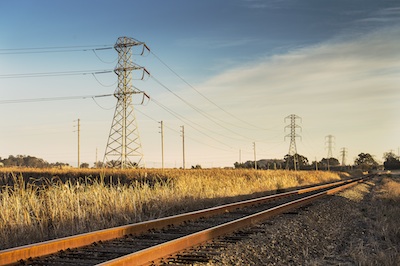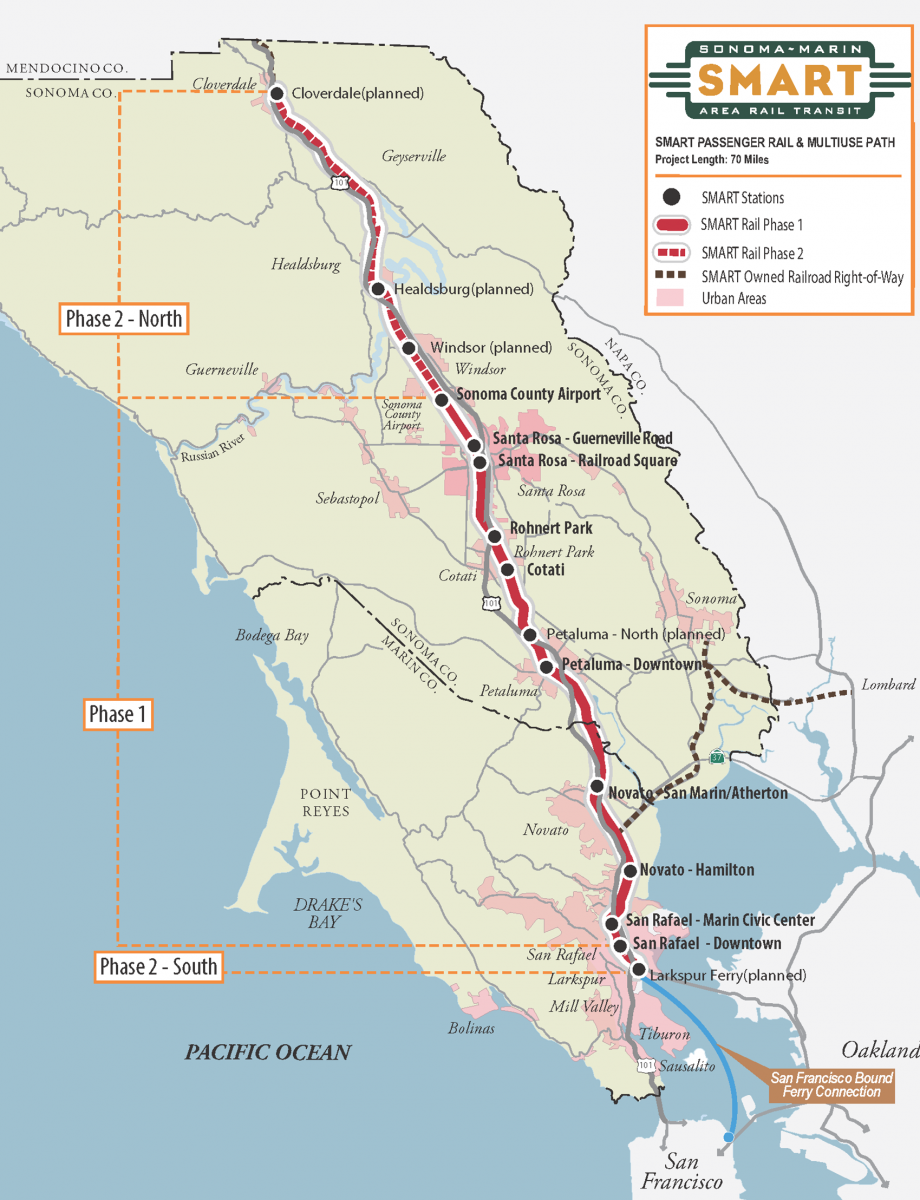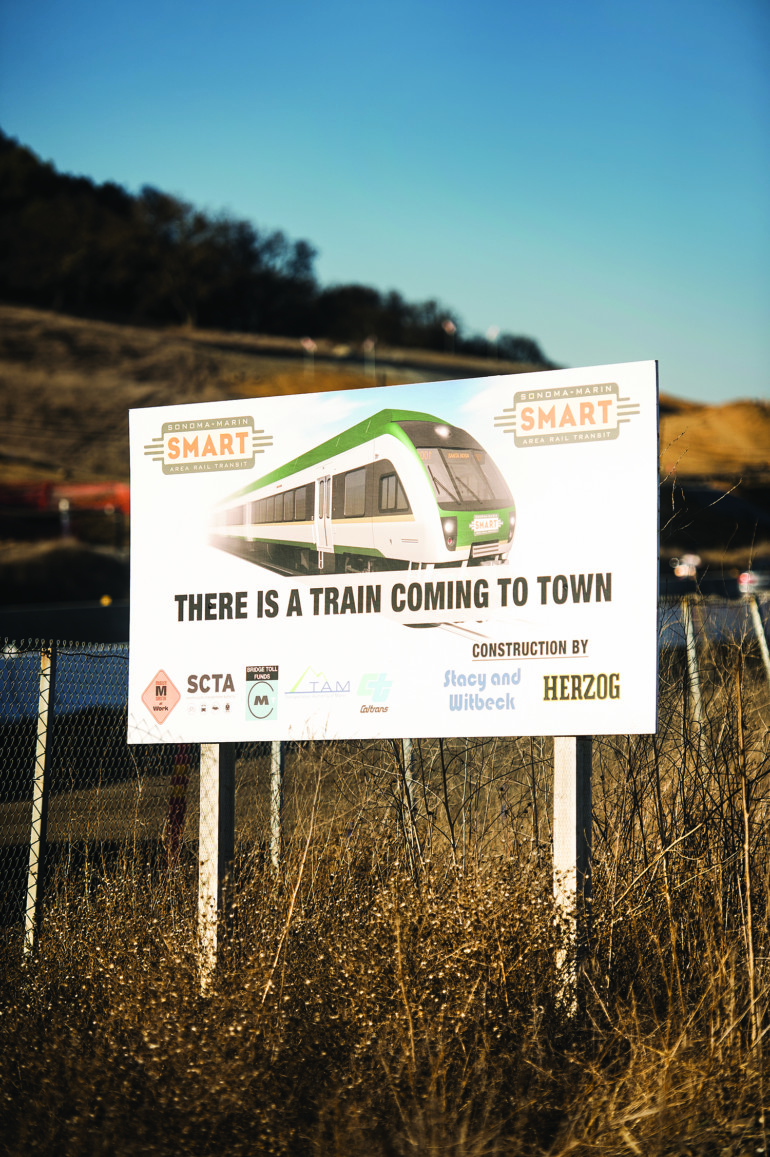 Imagine it's 2016 and you’re in Sonoma County, a quarter mile east of the county airport, and you want to reach Marin County, 48 miles away, and ultimately the Larkspur Landing ferry terminal. Here’s how SMART, the Sonoma-Marin Area Rail Transit — now under construction — will get you there.
Imagine it's 2016 and you’re in Sonoma County, a quarter mile east of the county airport, and you want to reach Marin County, 48 miles away, and ultimately the Larkspur Landing ferry terminal. Here’s how SMART, the Sonoma-Marin Area Rail Transit — now under construction — will get you there.
Boarding at the Airport Boulevard station, settle in for a four-mile run straight to the Guerneville Road station. SMART, as trains do, will pass through industrial landscape, but nearby are famous wineries such as John Ash & Co.’s Vintners Inn. Next stop: Railroad Square in downtown Santa Rosa — and it won’t take long, as SMART trains stop for no more than 40 seconds at each station (don’t worry, everything meets rigid safety requirements).
Though Rohnert Park is six miles away, it will take only minutes to get there because SMART trains reach 70 mph inside of 30 seconds. After you pass through more industrial areas and under Highway 101, Robert’s Lake Park and Foxtail Golf Club are on your left, and on the right, that’s the new Graton Resort and Casino. Next stop: Cotati, where a quaint but new depot awaits.
On to Petaluma. SMART’s run takes only five minutes and the stop is the decades-old train depot that’s been renovated and is now a visitor center. All aboard for Marin. But it isn’t the old Haystack Bridge that’s whisking you over the Petaluma River. This newer bridge was acquired from Galveston, Texas, was repurposed and has 85 years of useful life remaining. Now settle in for a 12-mile stretch through scenic backcountry to Novato’s San Marin–Atherton station, on the west side of Highway 101, walking distance to Fireman’s Fund and other employers.
Next stop: Hamilton. If you’re lunching at Hamilton Marketplace, you get off here. If not, SMART takes a picturesque three-mile loop behind St. Vincent’s School for Boys, past McInnis Park, then pulls into Marin County’s Civic Center station, located directly under Highway 101 (you can also walk from here to Northgate mall). The hop into downtown San Rafael — which appropriately stops at Whistlestop in the Transit Center — takes only two minutes and passes through the 1,300-foot-long, 80-year-old Puerto Suello tunnel, recently rebuilt to Federal Railroad Administration standards at a cost of $15 million. So it’s quick and clean.
Ah, but you wanted to reach Larkspur Landing and catch a ferry to San Francisco. If all goes as now anticipated, that will indeed be possible. According to SMART officials, a short but expensive stretch of new track is needed before you enter the already completed $28 million Cal Park tunnel and exit across Sir Francis Drake Boulevard from the ferry terminal. Currently, indications are positive that a Larkspur extension will be part of phase one and completed sometime in 2016.

The Plan
First, realize SMART is a diesel-powered train; it’s not an electric-powered light rail system like BART. In 2011, freight trains resumed running on the northern segment of SMART’s lines and they’ll continue running on them into the foreseeable future. Also realize that SMART was, in effect, given the land that comprises its right-of-way (see chronology), a benefit estimated to be worth a billion dollars. Currently, SMART train crews are laying all new track, ties and gravel ballast from northern Santa Rosa in Sonoma County, 43 miles south into downtown San Rafael and, as mentioned above, quite possibly on to the ferry terminal at Larkspur Landing. To date, 17 miles of track has been laid, all of it in Sonoma County.
“This is a huge project, the largest public works project in the history of either Sonoma or Marin county,” says SMART general manager Farhad Mansourian. “By comparison, Caltran’s Marin-Sonoma Narrows widening of Highway 101 is 18 miles long, and BART’s extension to San Jose is 17 miles long; what we’re building now is 43 miles long, possibly longer.” In addition to laying 43 miles of track, by the time the first phase is finished, SMART crews will have also constructed 10 stations and 41 signaled grade crossings, rebuilt two tunnels and rebuilt or replaced 20 bridges. “And remember,” Mansourian adds, “we are also building an operational train system that includes seven two-car train sets and all the personnel and programs needed to operate them safely, efficiently and effectively.” SMART plans call for the system to be operating by the end of 2016.
A 2005 Metropolitan Transportation Commission study indicated 17,000 residences and 40,000 jobs existed within half a mile of proposed stations. That survey did not include a SMART station near the Sonoma County Airport, which according to rail officials adds another 5,000 jobs to the mix and ultimately an expected 17,000 jobs by 2020. In all, 1.4 million passengers a year are expected to be served by SMART by the end of its first year of operation. And as Mansourian likes to point out, “Every time you spend $100 in Marin or Sonoma county, you’re paying 25 cents to create a transportation infrastructure that will last for many years to come. For some people it will be the only means of transportation; for others it will provide a choice.”
At present, SMART’s big unknown is the nearly two-mile segment from downtown San Rafael through Cal Park tunnel to a station a quarter of a mile from the Larkspur Landing ferry terminal. This extension has an estimated $40 million cost. Last year the Federal Transit Administration accepted this important link into its Small Starts program, indicating that federal funding could very well be provided for the segment’s completion.
Recently the Metropolitan Transportation Commission and the Transportation Authority of Marin recommended allocating $20 million toward the segment’s construction. “People have been calling lately,” reported Mansourian at the February board of directors meeting, “asking, ‘Now that you have the money, and the tracks are already there, when will SMART reach Larkspur?’ If only it were that simple.” Not only do all new rails and track beds have to be laid, he explains; the crossings of Francisco Boulevard West and Andersen Drive also present enormous and expensive engineering challenges. “But that’s our job,” he notes. “We’re engineers; we build things.”
The Challenges
Not that SMART’s progress to date has been without challenges. As approved by 69.6 percent of Sonoma and Marin county voters in 2008, the $540 million commuter rail line was to go from Larkspur 70 miles north to Cloverdale, in mid-Sonoma County, and be accompanied by a contiguous biking and hiking pathway. Basic funding was to be generated by a .25 percent increase in both counties’ sales tax. Then came the global financial crisis and resulting slump in tax revenues that reduced the project’s scope to what it is now. “But we’re continuing to work on that original vision, Larkspur to Cloverdale,” Mansourian says.
To date, $40 million in grants has come from such sources as Sonoma Open Space Conservancy, Sonoma County Transportation Authority, Transportation Authority of Marin, the Metropolitan Transportation Commission and the Federal Transit Administration. Another aspect of constructing a rail and pathway project is obtaining permits from regulatory agencies. According to documents, to date SMART has dealt with more than 15 governmental regulating and permitting agencies, among them the U.S. Army Corps of Engineers; National Oceanic and Atmospheric Administration; U.S. Coast Guard; Federal Railroad Administration; California Fish and Wildlife Department; California’s State Lands and Public Utilities commissions; and numerous state, regional, county and city agencies.
It is the intricate approval process, Mansourian says, that has posed pitfalls for the biking and hiking pathway. “Unfortunately, we can’t go into sensitive marshlands as we’d hoped to, which creates some disconnects; and the pathway will not always parallel the rail line as some expected it to.” Early feedback from local bicycle groups revealed the right-of-way was too narrow or traversed habitat too sensitive to accommodate some portions of the pathway. The result: 54 miles of Class One trails and 17 miles of Class Two trails or surface street connectors within the full 70-mile system (Cloverdale to Larkspur).
Portions of the pathway have been completed around Santa Rosa and, in Marin, the Cal Park tunnel connects Larkspur with San Rafael. Both segments are proving popular with cyclists and pedestrians, and more stretches will be built this year. However, Mansourian says, several portions are tied up in environmental reviews. “We’re dealing with the National Environmental Protection Act,” he says. “And that takes a very long time; it’s a lengthy procedure.” The good news: Completing the NEPA process qualifies these segments for potential federal funding.
The Operations
 As for times of day SMART trains will run and expected fares, “we’ll have trains arriving and departing every 30 minutes during peak commute hours, and one, possibly two trains running midday,” Mansourian says, with four trains running on weekends and holidays. “It’s too early to be specific” about fares, he adds, “but they will be competitive with other public transit options.” Also, use of Clipper, the popular all-inclusive Bay Area transportation payment card, is definitely under consideration. As for parking, most SMART stations will have newly constructed lots or will rely on parking that exists nearby. SMART officials are working with local transit providers in both counties to coordinate routes that will shuttle passengers to their nearest station. And until phase two is completed, Express Connector buses will transport passengers to SMART’s future stations in Windsor, Healdsburg and Cloverdale.
As for times of day SMART trains will run and expected fares, “we’ll have trains arriving and departing every 30 minutes during peak commute hours, and one, possibly two trains running midday,” Mansourian says, with four trains running on weekends and holidays. “It’s too early to be specific” about fares, he adds, “but they will be competitive with other public transit options.” Also, use of Clipper, the popular all-inclusive Bay Area transportation payment card, is definitely under consideration. As for parking, most SMART stations will have newly constructed lots or will rely on parking that exists nearby. SMART officials are working with local transit providers in both counties to coordinate routes that will shuttle passengers to their nearest station. And until phase two is completed, Express Connector buses will transport passengers to SMART’s future stations in Windsor, Healdsburg and Cloverdale.
Some might find it interesting that SMART stations have already been completed at both Windsor and Cloverdale, even though these are considerably north of SMART’s phase one terminus at the Sonoma County Airport. But not Mansourian. “My task is to build a train that goes from Larkspur to Cloverdale,” he says enthusiastically. “That’s what voters approved in 2008 and my staff and I are to doing everything we can to see that that happens. We’re looking for money whenever and wherever we can find it.”
SMART main office: 5401 Old Redwood Highway, Suite 200, Petaluma, 707.794.3330. Construction information: 855.312.7444. sonomamarintrain.org, info@sonomamarin train.org. Facebook: facebook.com/sonomamarintrain, Twitter: @smarttrain.


